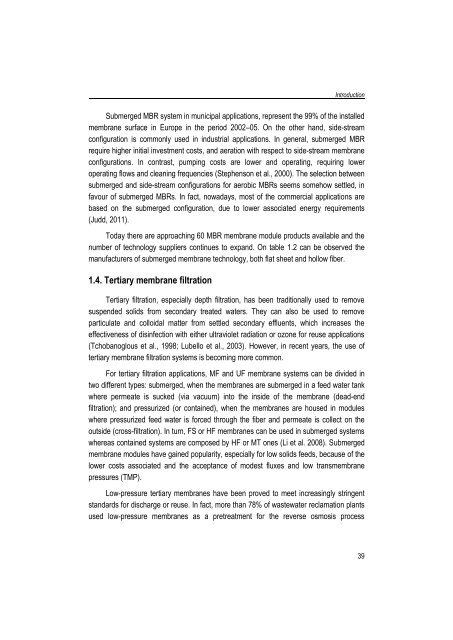Combining submerged membrane technology with anaerobic and ...
Combining submerged membrane technology with anaerobic and ...
Combining submerged membrane technology with anaerobic and ...
You also want an ePaper? Increase the reach of your titles
YUMPU automatically turns print PDFs into web optimized ePapers that Google loves.
IntroductionSubmerged MBR system in municipal applications, represent the 99% of the installed<strong>membrane</strong> surface in Europe in the period 2002–05. On the other h<strong>and</strong>, side-streamconfiguration is commonly used in industrial applications. In general, <strong>submerged</strong> MBRrequire higher initial investment costs, <strong>and</strong> aeration <strong>with</strong> respect to side-stream <strong>membrane</strong>configurations. In contrast, pumping costs are lower <strong>and</strong> operating, requiring loweroperating flows <strong>and</strong> cleaning frequencies (Stephenson et al., 2000). The selection between<strong>submerged</strong> <strong>and</strong> side-stream configurations for aerobic MBRs seems somehow settled, infavour of <strong>submerged</strong> MBRs. In fact, nowadays, most of the commercial applications arebased on the <strong>submerged</strong> configuration, due to lower associated energy requirements(Judd, 2011).Today there are approaching 60 MBR <strong>membrane</strong> module products available <strong>and</strong> thenumber of <strong>technology</strong> suppliers continues to exp<strong>and</strong>. On table 1.2 can be observed themanufacturers of <strong>submerged</strong> <strong>membrane</strong> <strong>technology</strong>, both flat sheet <strong>and</strong> hollow fiber.1.4. Tertiary <strong>membrane</strong> filtrationTertiary filtration, especially depth filtration, has been traditionally used to removesuspended solids from secondary treated waters. They can also be used to removeparticulate <strong>and</strong> colloidal matter from settled secondary effluents, which increases theeffectiveness of disinfection <strong>with</strong> either ultraviolet radiation or ozone for reuse applications(Tchobanoglous et al., 1998; Lubello et al., 2003). However, in recent years, the use oftertiary <strong>membrane</strong> filtration systems is becoming more common.For tertiary filtration applications, MF <strong>and</strong> UF <strong>membrane</strong> systems can be divided intwo different types: <strong>submerged</strong>, when the <strong>membrane</strong>s are <strong>submerged</strong> in a feed water tankwhere permeate is sucked (via vacuum) into the inside of the <strong>membrane</strong> (dead-endfiltration); <strong>and</strong> pressurized (or contained), when the <strong>membrane</strong>s are housed in moduleswhere pressurized feed water is forced through the fiber <strong>and</strong> permeate is collect on theoutside (cross-filtration). In turn, FS or HF <strong>membrane</strong>s can be used in <strong>submerged</strong> systemswhereas contained systems are composed by HF or MT ones (Li et al. 2008). Submerged<strong>membrane</strong> modules have gained popularity, especially for low solids feeds, because of thelower costs associated <strong>and</strong> the acceptance of modest fluxes <strong>and</strong> low trans<strong>membrane</strong>pressures (TMP).Low-pressure tertiary <strong>membrane</strong>s have been proved to meet increasingly stringentst<strong>and</strong>ards for discharge or reuse. In fact, more than 78% of wastewater reclamation plantsused low-pressure <strong>membrane</strong>s as a pretreatment for the reverse osmosis process39
















